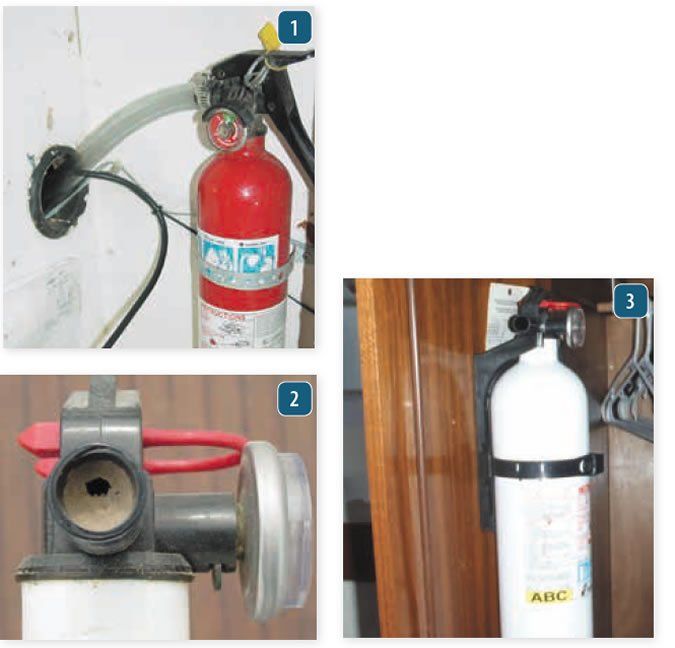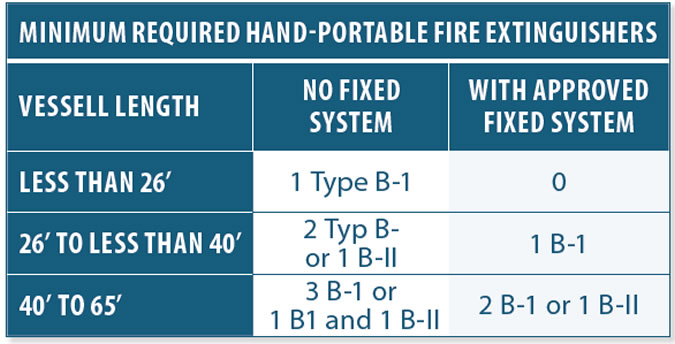While portable dry chemical fire extinguishers are a common sight aboard any sailboat, their installation, upkeep, and use is almost sinful. During marine surveys Ive asked boat owners how long they think a typical BC-I portable unit will last when fighting a fire and have received answers ranging from about 20 minutes to until the fire is put out-scary, when you consider that the correct answer is around 10 seconds of continuous use.
Routine fire extinguisher inspections are crucial to ensure proper operation when needed. Your first check should be verifying you have the correct number and type of Coast Guard approved extinguishers onboard for your particular boat (see table). These standards are the MINIMUM and its always good to have additional units onboard. Extinguishers should be located in easily visible locations near the galley, engine compartment and all living spaces. A good rule of thumb is that you should never have to travel more than half the length of your boat to reach an extinguisher. Although not preferred, if you have to mount an extinguisher in a locker or cabinet, be sure to install a label or placard outside the cabinet indicating a fire extinguisher is located inside.
A common problem I see is having the correct number of fire extinguishers onboard, but locating all of them below decks where a galley fire could prevent access from the helm. Sailboats are particularly susceptible in this regard, since the galley is usually near the companionway. Always mount an extinguisher in the cockpit area, where its available to the helmsman the minute a fire is discovered.

Portable fire extinguishers have different maintenance schedules based on their type and extinguishing agent. Inspect yours monthly for loss of pressure, corrosion, damaged mounting brackets, clogged nozzles, etc. Its also recommended that units be professionally inspected and tagged annually.
Unless you have a fixed, automatic extinguisher installed in the engine compartment, installation of a fire port is highly recommended. A fire or discharge port allows you to discharge a suitably sized clean agent portable fire extinguisher (i.e. CO2, Halotron, FM-200, FE-241) directly into the engine compartment without opening any access panels. A fire port must be sized to fit the portable fire extinguisher discharge nozzle, so the extinguisher can be used as the maker recommends. In my view, these ports are often too small to get the job done.
Using a clean agent extinguisher. for engine space fires is important. The dry chemicals in standard extinguishers is corrosive and hard to remove afterwards. It can actually cause more damage to the engine than the fire itself. A clean agent extinghisher smothers the fire by flooding the engine compartment, while dry chemical units have to be aimed directly at the base of the fire to be effective.
Capt. Frank Lanier is an accredited marine surveyor with over 30 years of experience in the marine industry. His website is www.captfklanier.com.

The Federal minimum standards could leave you ill-to fight a serious onboard fire.







































What would be considered a clean agent extinguisher? I also highly recommend fire blankets, especially for galley fires. These are highly effective, rapidly deployable, and involve no chemicals. They cost under $10 each.
CO2, Halotron, FM-200, FE-241…as he mentioned in the article. But my reason for posting is to second your comment about fire blankets; every galley should have one. Plus, there’s a chance that if you can put the fire out quickly, your dinner will still be edible! Try that with your typical dry chemical extinguisher…
Caveat to my previous remark; cheaper blankets might leave some fiberglass fibers in your hash browns…so you might want to toss your breakfast, but at least you won’t be trying to clean dry chemical out of your galley.
Hi there, Very informative post, thank you for taking the time to write this all out!
It’s natural to be concerned about where fire extinguishers should be stored on a boat to be prepared for an emergency. I do still have a question as where should fire extinguishers be stored on a boat?
Again thanks!